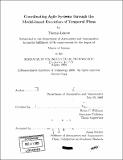| dc.contributor.advisor | Brian C. Williams. | en_US |
| dc.contributor.author | Léauté, Thomas | en_US |
| dc.contributor.other | Massachusetts Institute of Technology. Dept. of Aeronautics and Astronautics. | en_US |
| dc.date.accessioned | 2006-11-07T17:19:09Z | |
| dc.date.available | 2006-11-07T17:19:09Z | |
| dc.date.copyright | 2005 | en_US |
| dc.date.issued | 2005 | en_US |
| dc.identifier.uri | http://hdl.handle.net/1721.1/34681 | |
| dc.description | Thesis (S.M.)--Massachusetts Institute of Technology, Dept. of Aeronautics and Astronautics, 2005. | en_US |
| dc.description | Includes bibliographical references (p. 149-155). | en_US |
| dc.description.abstract | Agile autonomous systems are emerging, such as unmanned aerial vehicles (UAVs), that must robustly perform tightly coordinated time-critical missions; for example, military surveillance or search-and-rescue scenarios. In the space domain, execution of temporally flexible plans has provided an enabler for achieving the desired coordination and robustness, in the context of space probes and planetary rovers, modeled as discrete systems. We address the challenge of extending plan execution to systems with continuous dynamics, such as air vehicles and robot manipulators, and that are controlled indirectly through the setting of continuous state variables. Systems with continuous dynamics are more challenging than discrete systems, because they require continuous, low-level control, and cannot be controlled by issuing simple sequences of discrete commands. Hence, manually controlling these systems (or plants) at a low level can become very costly, in terms of the number of human operators necessary to operate the plant. For example, in the case of a fleet of UAVs performing a search-and-rescue scenario, the traditional approach to controlling the UAVs involves providing series of close waypoints for each aircraft, which incurs a high workload for the human operators, when the fleet consists of a large number of vehicles. | en_US |
| dc.description.abstract | (cont.) Our solution is a novel, model-based executive, called Sulu, that takes as input a qualitative state plan, specifying the desired evolution of the state of the system. This approach elevates the interaction between the human operator and the plant, to a more abstract level where the operator is able to "coach" the plant by qualitatively specifying the tasks, or activities, the plant must perform. These activities are described in a qualitative manner, because they specify regions in the plant's state space in which the plant must be at a certain point in time. Time constraints are also described qualitatively, in the form of flexible temporal constraints between activities in the state plan. The design of low-level control inputs in order to meet this abstract goal specification is then delegated to the autonomous controller, hence decreasing the workload per human operator. This approach also provides robustness to the executive, by giving it room to adapt to disturbances and unforeseen events, while satisfying the qualitative constraints on the plant state, specified in the qualitative state plan. Sulu reasons on a model of the plant in order to dynamically generate near-optimal control sequences to fulfill the qualitative state plan. To achieve optimality and safety, Sulu plans into the future, framing the problem as a disjunctive linear programming problem. | en_US |
| dc.description.abstract | (cont.) To achieve robustness to disturbances and maintain tractability, planning is folded within a receding horizon, continuous planning and execution framework. The key to performance is a problem reduction method based on constraint pruning. We benchmark performance using multi-UAV firefighting scenarios on a real-time, hardware-in-the-loop testbed. | en_US |
| dc.description.statementofresponsibility | by Thomas Léauté. | en_US |
| dc.format.extent | 155 p. | en_US |
| dc.format.extent | 8104064 bytes | |
| dc.format.extent | 8110561 bytes | |
| dc.format.mimetype | application/pdf | |
| dc.format.mimetype | application/pdf | |
| dc.language.iso | eng | en_US |
| dc.publisher | Massachusetts Institute of Technology | en_US |
| dc.rights | M.I.T. theses are protected by copyright. They may be viewed from this source for any purpose, but reproduction or distribution in any format is prohibited without written permission. See provided URL for inquiries about permission. | en_US |
| dc.rights.uri | http://dspace.mit.edu/handle/1721.1/7582 | |
| dc.subject | Aeronautics and Astronautics. | en_US |
| dc.title | Coordinating agile systems through the model-based execution of temporal plans | en_US |
| dc.title.alternative | Coordinating agile vehicles through the model-based execution of temporal plans | en_US |
| dc.type | Thesis | en_US |
| dc.description.degree | S.M. | en_US |
| dc.contributor.department | Massachusetts Institute of Technology. Department of Aeronautics and Astronautics | |
| dc.identifier.oclc | 67776795 | en_US |
